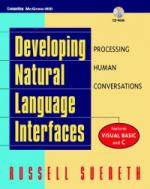
NEWS: Chatbots.org survey on 3000 US and UK consumers shows it is time for chatbot integration in customer service!read more..
Developing Natural Language Interfaces
Processing Human Conservations

All modern software applications use graphical user interface to display information, with the keyboard or mouse button used to interact with the computer. This book covers the subject of natural language interfaces: computers which are activated, operated and respond to ordinary conversational English, a technology based on the principle that the most natural method of communication is speech. The text offers practical guidance on developing effective, working natural language interfaces, also including examples of ready-to-run programs in Visual Basic, C and C++.
The book is a practical help for programmers and developers working at the forefront of language processing. A computer’s ability to communicate using ordinary conversational English used to be the subject of abstract theoretical tomes. Not any longer, thanks to this highly practical guide. Developing Natural Language Interfaces shows programmers and developers how to actually build the software that provides basic conversation processing. It also describes, step by step,how you can incorporate more sophisticated language processing capabilities. No matter what Windows-based application you’re working in,this book delivers the programming code and easy-to-follow examples you need to take that quantum leap from graphical interfaces. In fact,each chapter contains an example program with a complete description and analysis. And the accompanying CD-ROM includes all examples referred to in the book in both VBA (Visual Basic for applications) and ANSI C,which can be used with any C or C++ compiler and on a multitude of operating systems. Well-illustrated with numerous tables and figures,this book provides clear and implementable discussions of such key topics as: Incorporating sufficent knowledge about grammar into a conversation processor; Resolving the potential problems that may arise from ambiguous,incomplete,or inconsistent meanings; Defining sentence elements,identifying phrases,and including idioms and synonyms; Converting long run-on sentences into more easily recognizable forms; Reading characters and sentences from a text file,and identifying themes.
New Comment
Only registered members are allowed to comment. or login
or login
